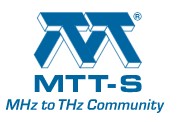Bringing EDA-Tool Schematics into LaTeX – An Open-Source Solution
Presenter
Christof Pfannenmüller
Email: christof.pfannenmueller@fau.de
Affiliation
Lehrstuhl für Technische Elektronik
Team Radio & Biomedical Applications
Abstract
Current EDA tools like PathWave Advanced Design System or Cadence Virtuoso support various formats for data interchange and documentation exports. We propose an open-source solution for directly transferring schematic data to the nodebased drawing environment TikZ and its extension CircuiTikZ for electrical schematic drawings. Schematics are exported as XML-based file structures via ADS Board Link (ABL). Using this input, the proposed tool can recalculate components and their placements and convert them to TikZ-based source code. With these, the schematic can be used in LaTeX documents.
Demo Overview
This demo will contain a live view of several Keysight ADS schematics and their conversion with the proposed open-source JavaScript-based tool. Afterward, the results are shown in a LaTeX document for comparison. A computer with the necessary installed software will be provided. No additional equipment will be required for the demo.
Nature-Inspired All-Space Multi-Antenna Array Architecture
Presenter
Dr. Pavlo Molchanov
Email: mpavlo2003@yahoo.com
Affiliation
IPD Scientific LLC
Abstract
The nature-inspired all-space multi-antenna array architecture combines various techniques to achieve wide-area multi-orbit observation, fast simultaneous signal processing, high directional accuracy, enhanced reliability, and communication quality. The key elements and features of the architecture: Holographic wide area of observation with staring antenna array; Monopulse method of fast simultaneous signals processing; Direct Digitizing Signals on Multi-Axis Overlap Directional Antennas; Integration of Antennas with Signal Conditioning Circuits and SDR; Distributed Placement for System Protection; Transformation and Processing in Multiple Domains. Moreover, the application of wide numerical aperture overlap antennas allows the detection and recognition of different objects in high-scattering mediums by measurement of the Fresnel diffraction patterns and angular spectrum of scattered and diffraction components. Fourier transform and digital multi-domain digitizing can provide reliable recognition of objects by spectrum signatures and separation of transferring medium and objects.
Demo Overview
The demonstration setup will consist of a low-power transmitter module and a receiving module connected to two separate directional antennas by flexible coaxial cables. The receiving module can be connected to a phase detector or Software Determined Radion (SDR). This setup allows for a demonstration of key features of the array architecture, as well as the recognition of different objects using their spectrum signatures. Remote detection and recognition of concealed objects will be also demonstrated.
mmW-OAI: The Easiest Way to Establish a 5G FR2 End-to-End Test Network
Presenter
Ethan Lin
Email: ariel_chiang@tmytek.com & grace_ho@tmytek.com
Affiliation
TMY Technology, Inc. (TMYTEK)
Abstract
Do you happen to have one or two spare SDRs on hand? Have you ever thought about establishing a complete 5G FR2 end-to-end network with your SDRs? TMYTEK will introduce the mmW-OAIBOX, an FR2-enabled OAI testbed that TMYTEK worked on with Allbesmart. It is worth noting that this solution has already been delivered to Japan. Incorporating the best of millimeter-wave and OpenAirInterface (OAI), we provide a comprehensive test environment from UE to the core network. The mmW-OAIBOX offers 5G beamformers to mimic gNB and UE array antennas, a frequency converter, a powerful PC installed with the latest OAI stack, including OAI gNB, CN5G, a dashboard, and more. We will show you how to use the APIs to control TMYTEK FR2 devices, including a 24-44 GHz up/down converter (UD Box) and a 28 GHz mmWave beamformer (BBox), with your SDR development environment. This will include an API introduction, control calls, DLL imports, and more. There are many topics that need to be addressed in wireless research. We have built the most advanced tools to unleash your creativity, so you are able to develop innovative solutions for the next generation of wireless technology.






